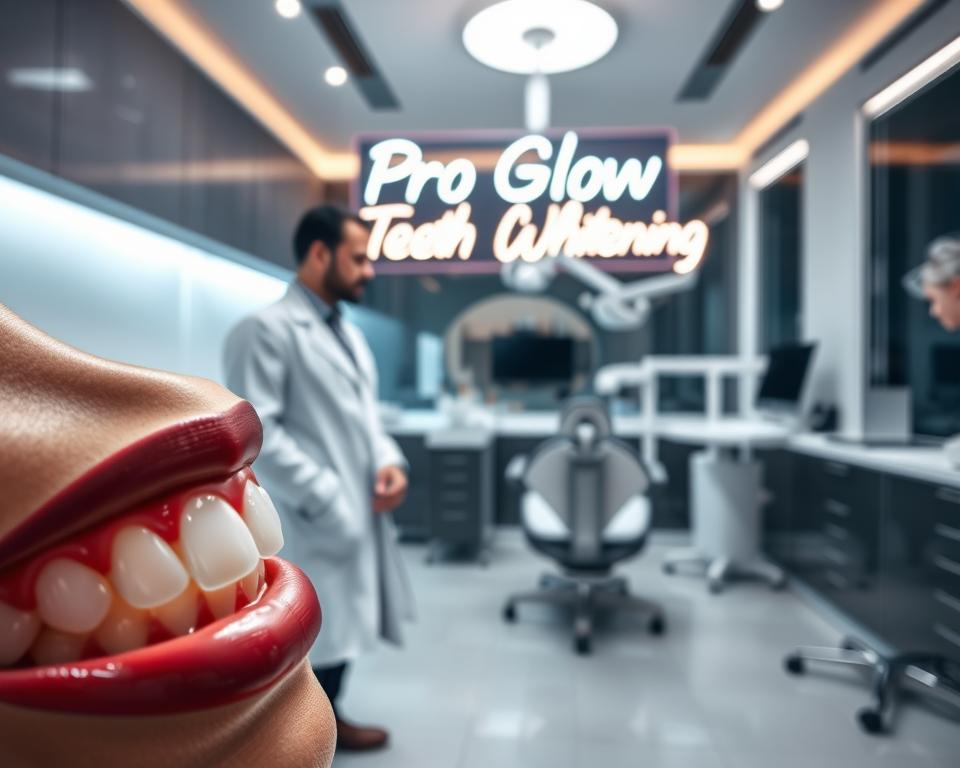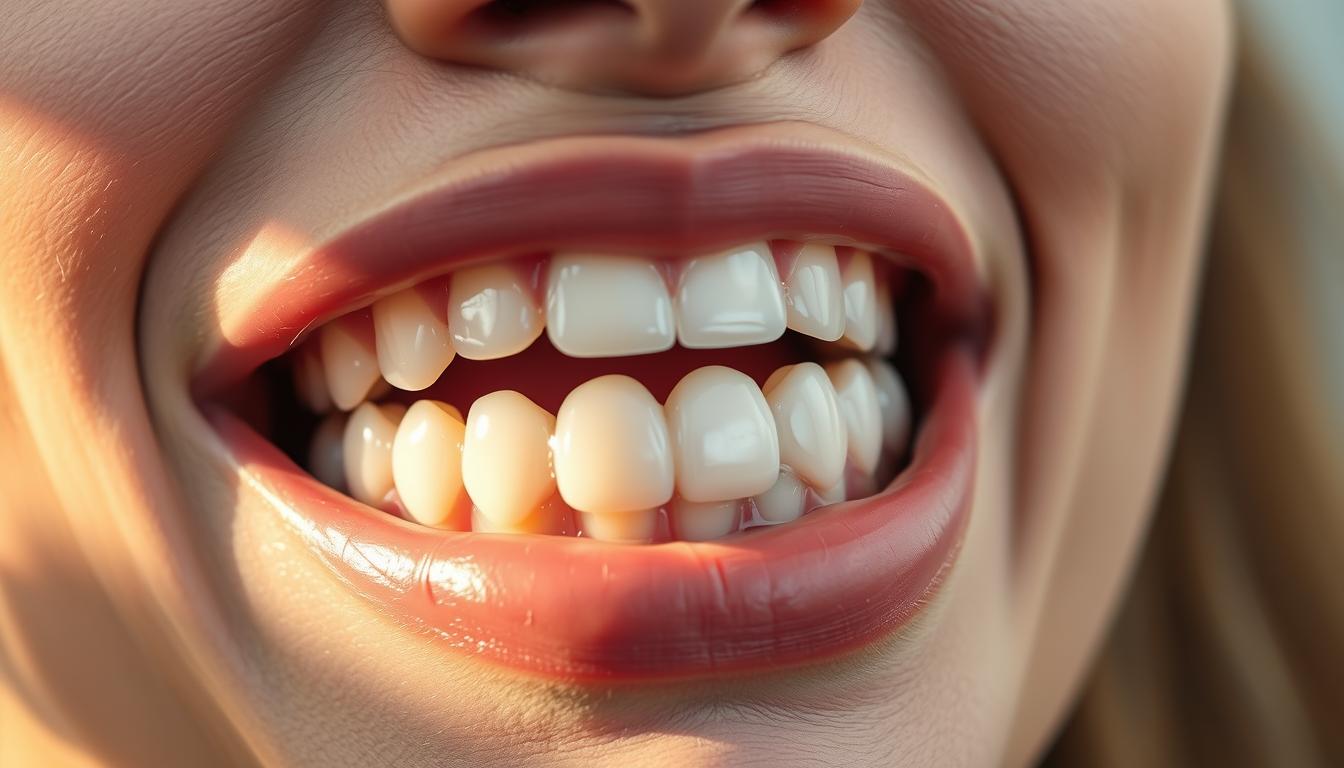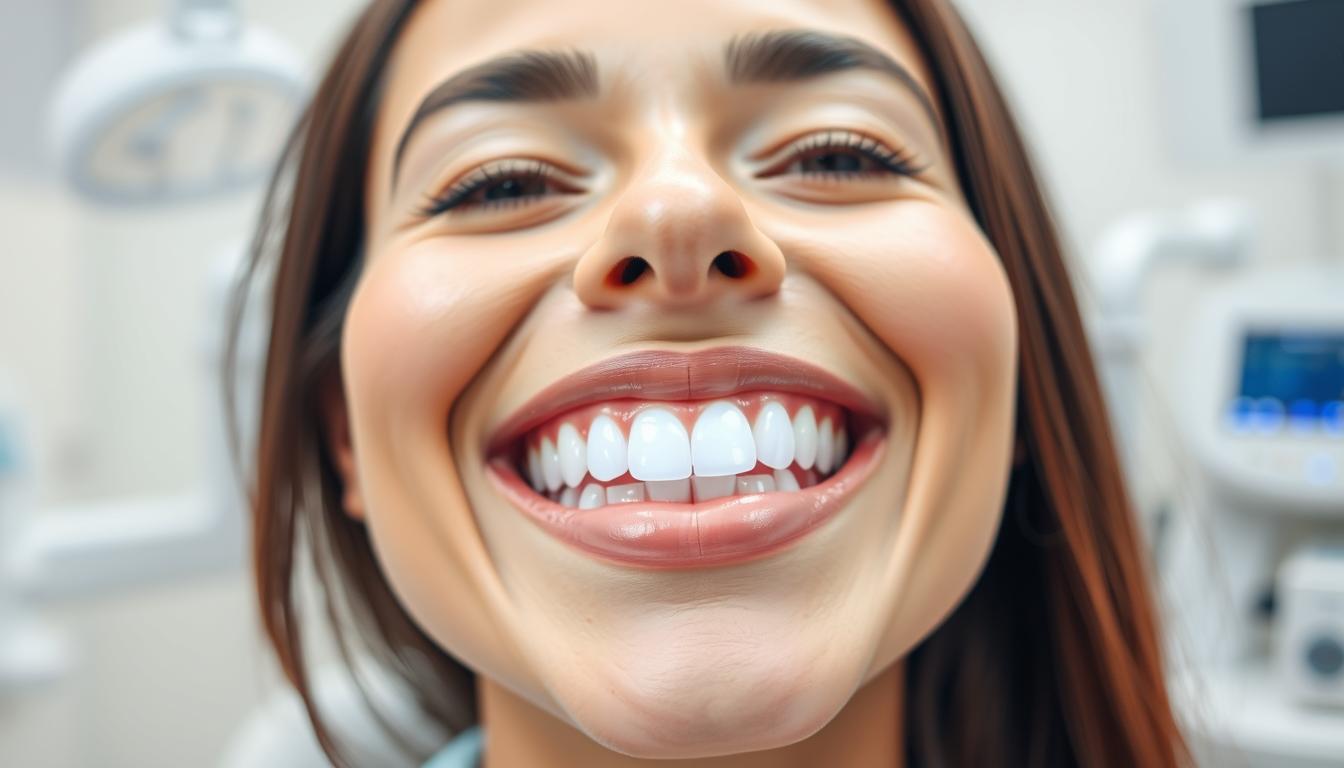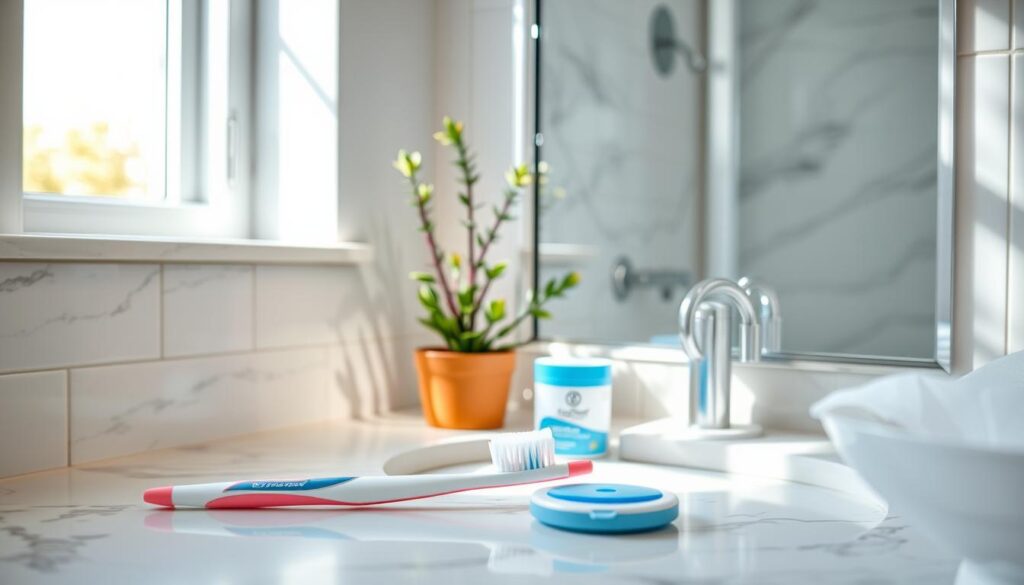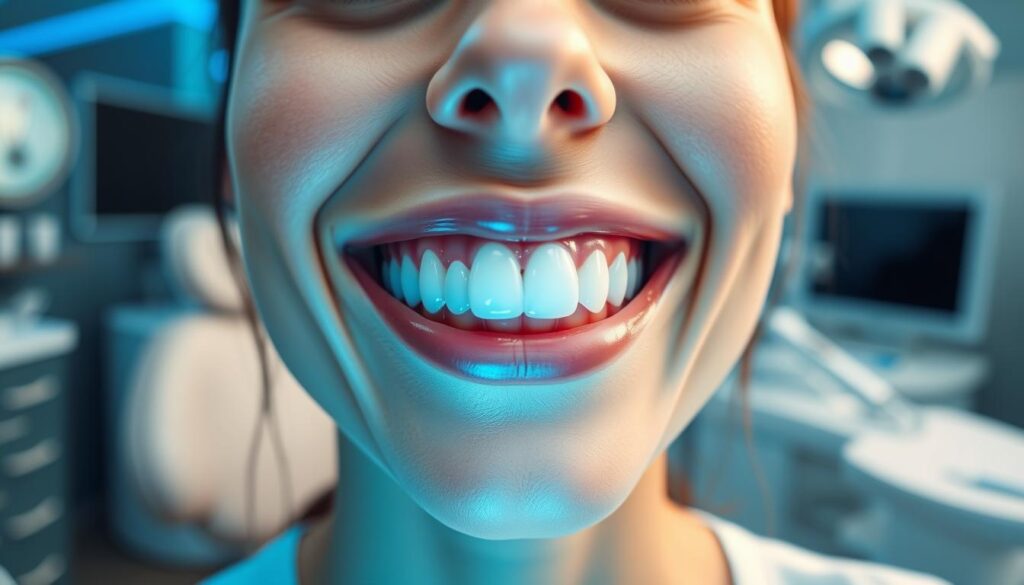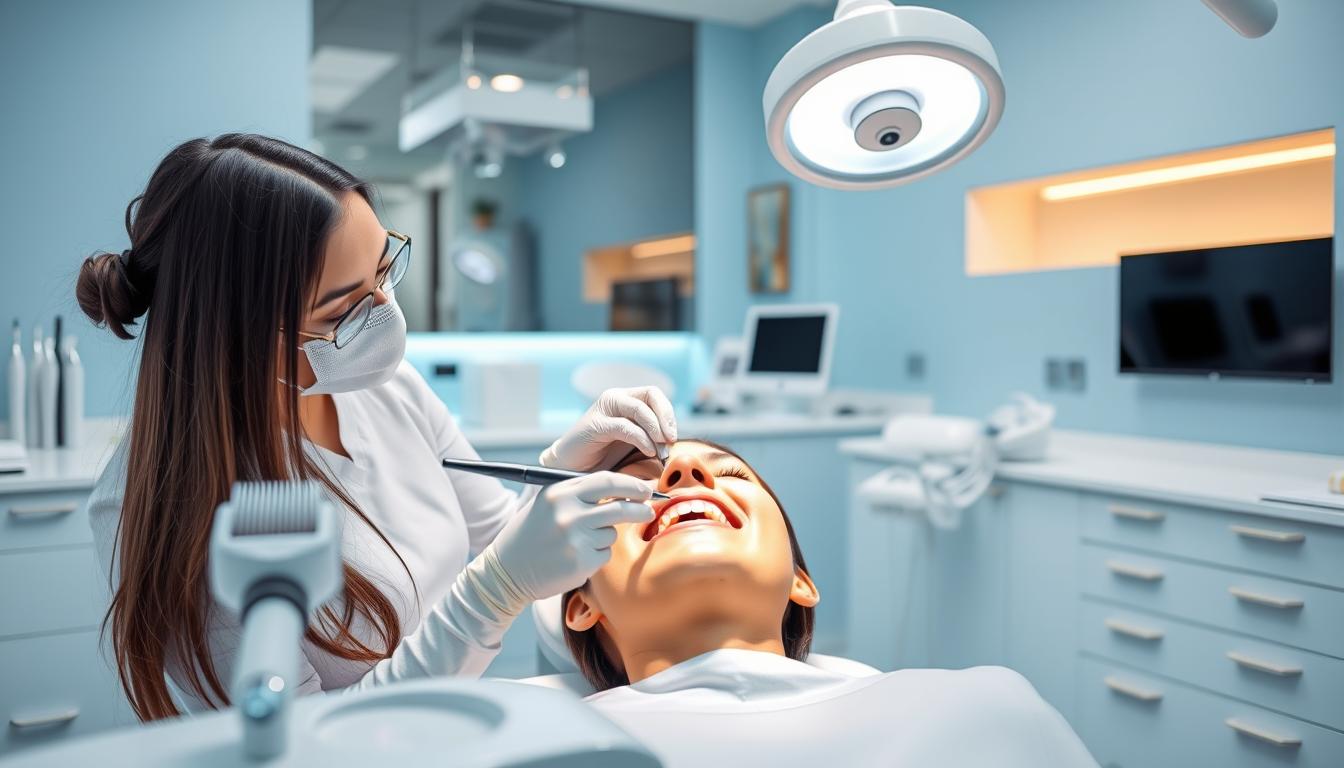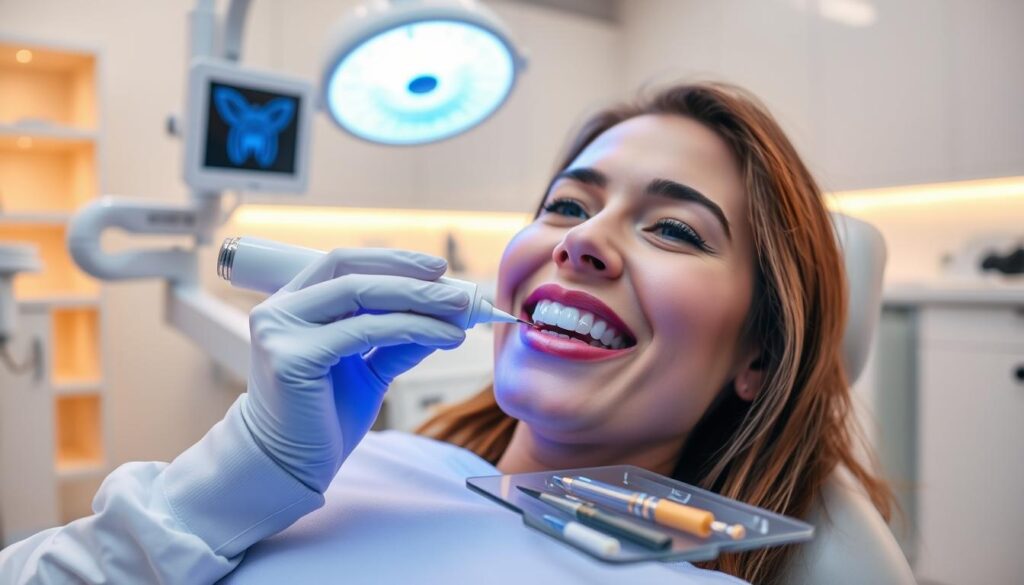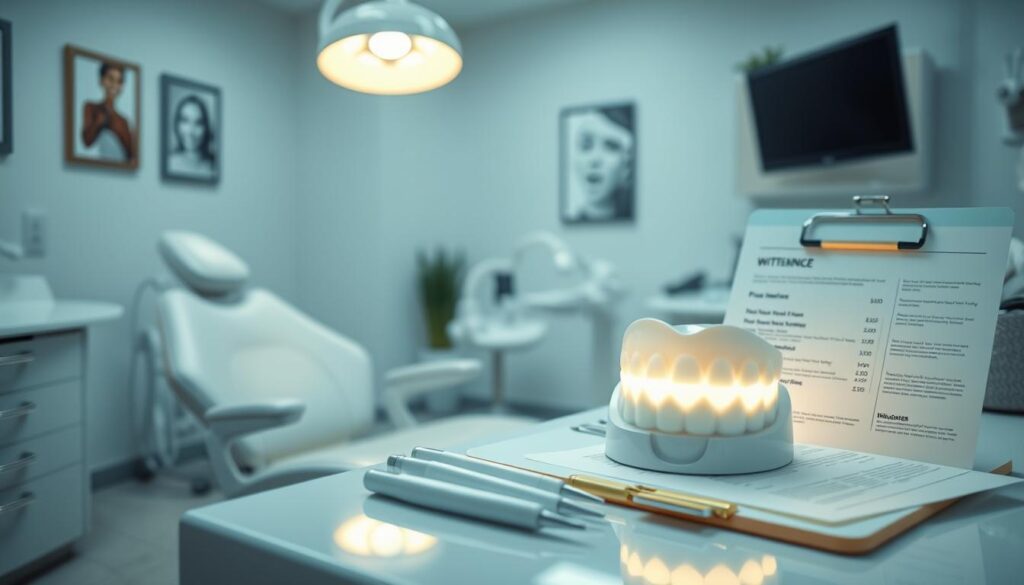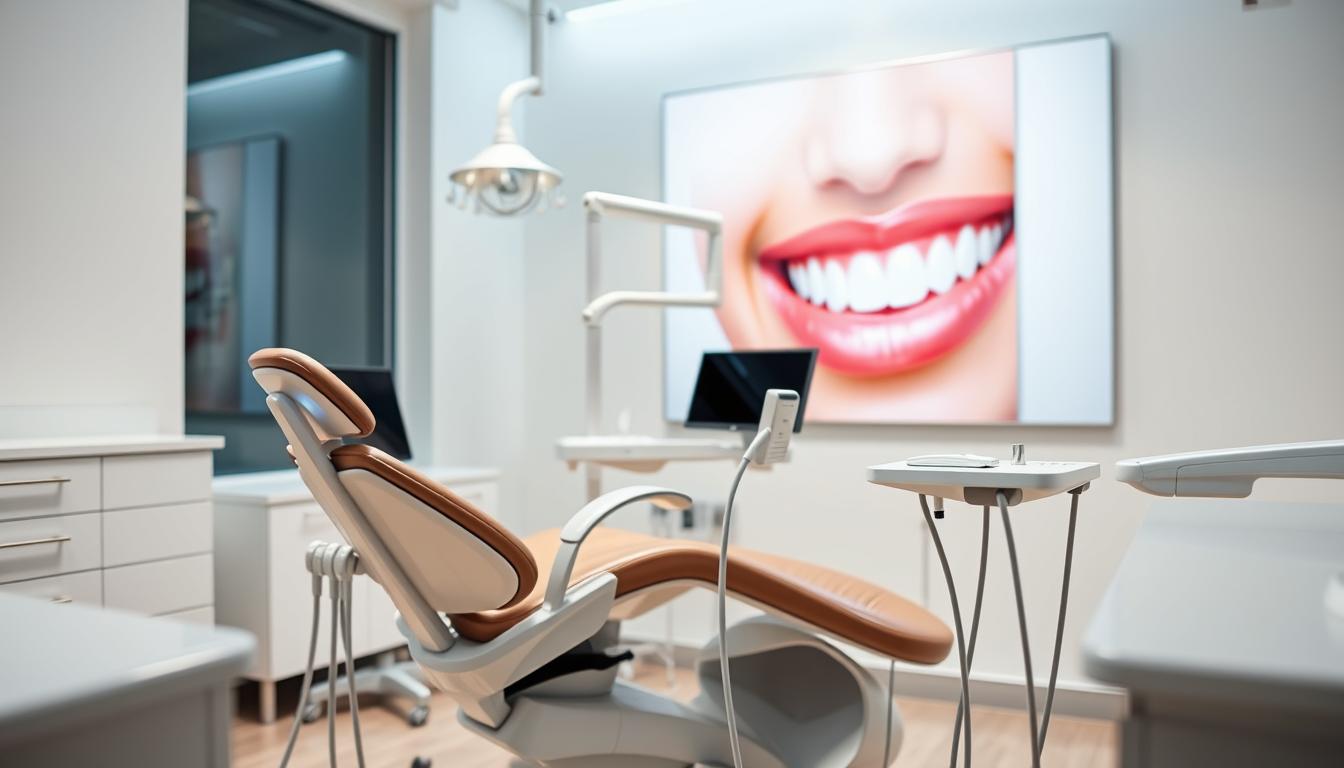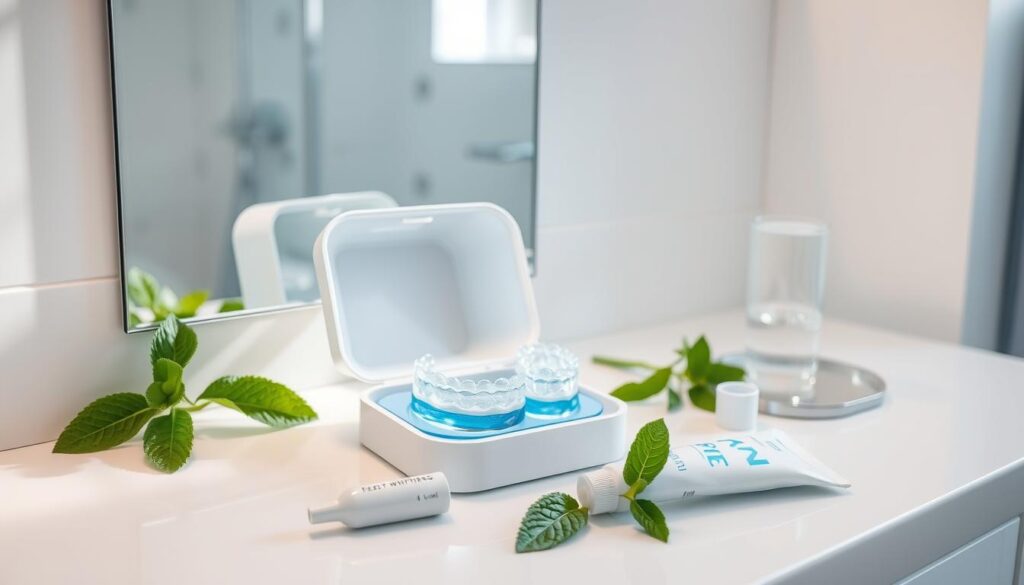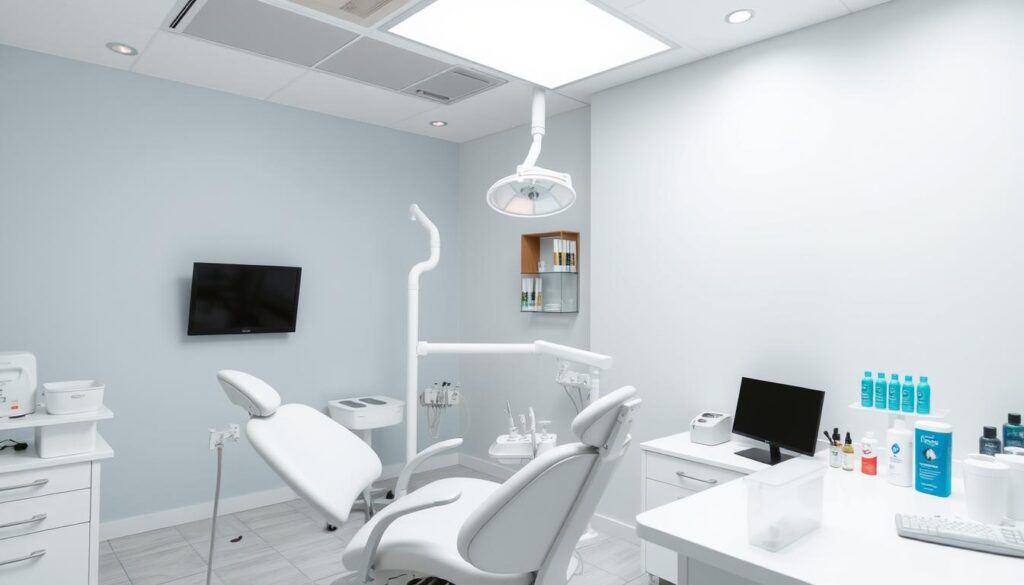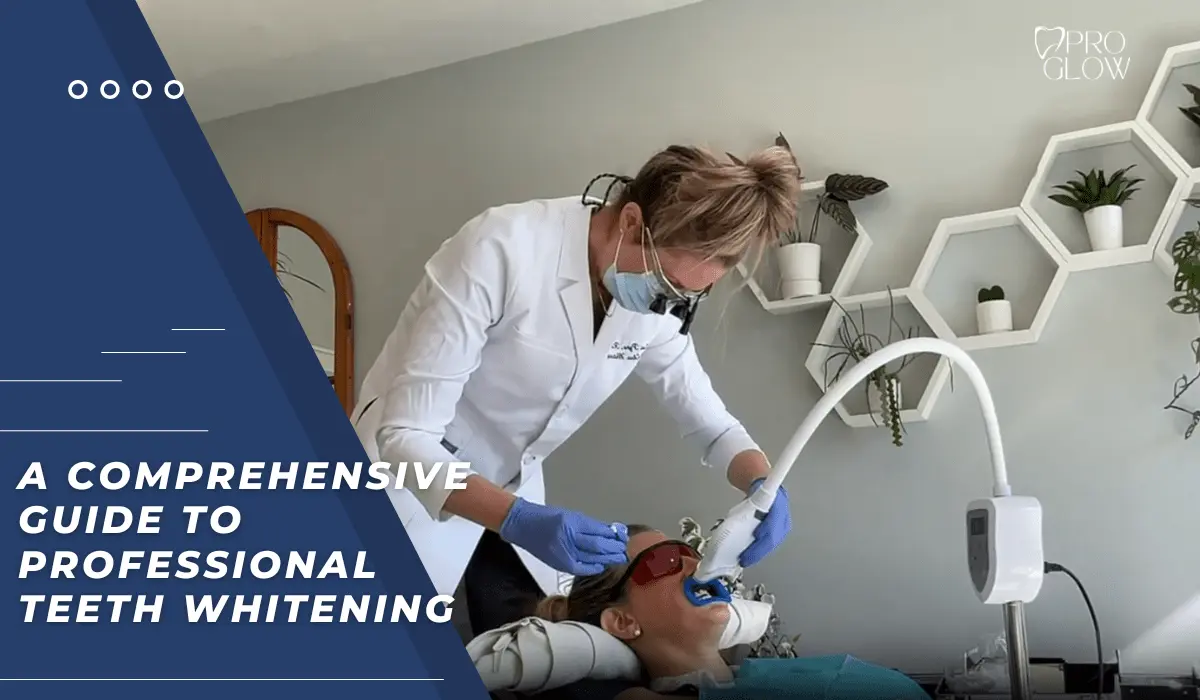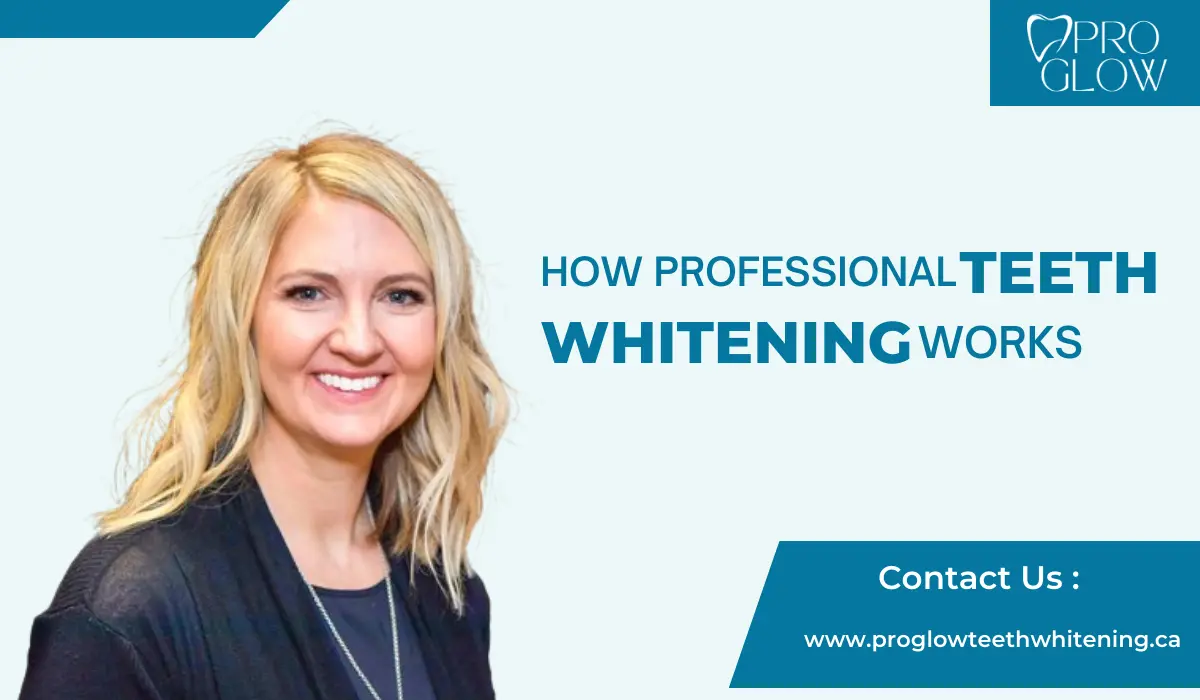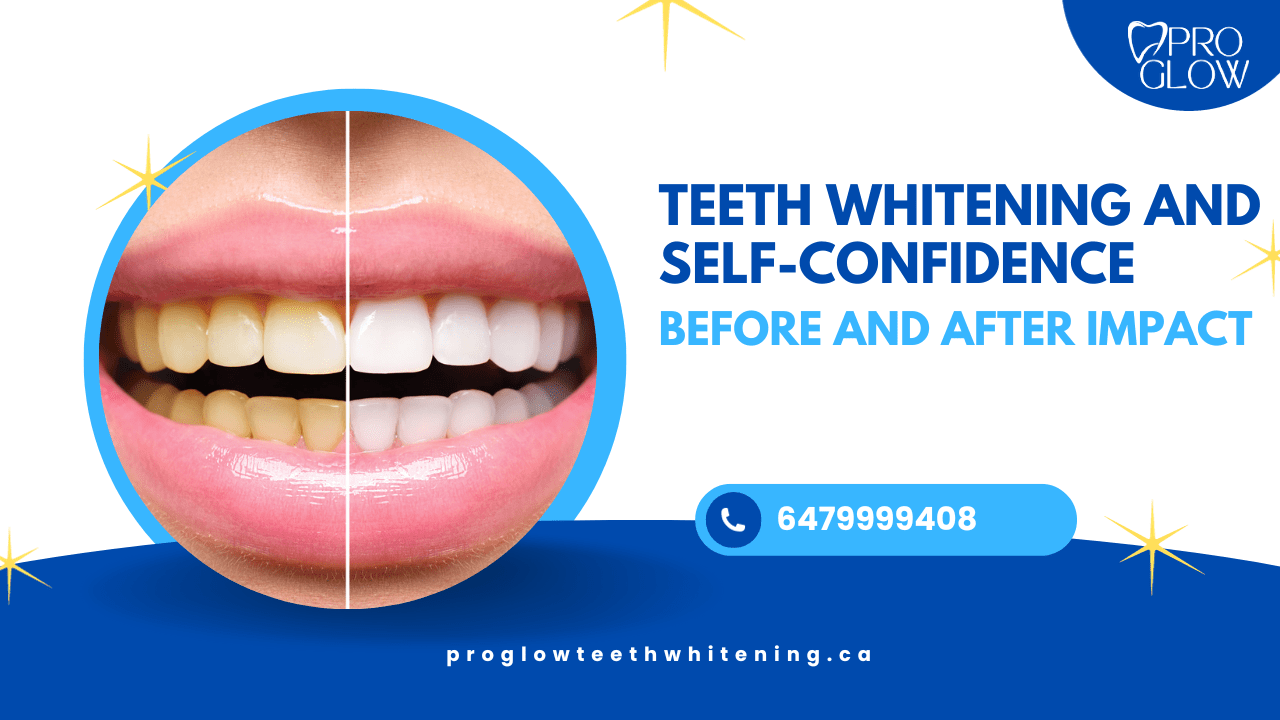Getting a brighter smile is easier than ever with dentist-supervised treatments. These procedures use advanced bleaching agents and technologies to deliver predictable, long-lasting results. Unlike at-home kits, they are safer and more effective, often lasting up to two years.
During the process, your dentist removes plaque and applies a hydrogen peroxide solution. This is activated by a laser or light, ensuring a dramatic transformation. You can even choose your desired shade for a personalized result.
To maintain your new smile, proper care is essential. Avoiding staining foods and drinks, along with regular dental visits, can help preserve the effects. With the right steps, you can enjoy a radiant smile for years to come.
Key Takeaways
- Dentist/Hygienist-supervised treatments use advanced bleaching agents for better results.
- These procedures are safer and more effective than at-home kits.
- The process includes plaque removal and activation by light or laser.
- Results can last up to two years with proper care.
- Avoid staining foods and drinks to maintain your bright smile.
Understanding the Benefits and Process of Professional in office teeth whitening
Achieving a radiant smile is simpler with expert-guided treatments. These procedures are designed to deliver predictable, long-lasting results while minimizing risks. Unlike at-home kits, dentist/hygienist-led whitening uses advanced techniques and higher-concentration bleaching agents for better outcomes.
The Superiority of Dentist-Led Treatments
Dentist/hygienist supervision ensures the process is safe and effective. Stronger bleaching agents, like hydrogen peroxide, are used under careful monitoring. This reduces the risk of side effects such as sensitivity.
Each treatment is tailored to the patient’s unique needs. Customized shade charts help select the ideal tone for a natural yet bright smile. This level of personalization is unmatched by at-home options.
Predictable, Long-Lasting Results
In-office treatments offer fast transformation, often in a single session. Clinical data shows results can last up to one -two years with proper care. The controlled application method ensures even whitening without streaks or patches.
Regular follow-ups and maintenance tips from your dentist help preserve the effects. Avoiding staining foods and drinks is also key to maintaining your new smile.
| Feature | In-Office Whitening | At-Home Kits |
|---|---|---|
| Bleaching Agent Strength | High-concentration | Low-concentration |
| Supervision | Dentist/hygienist-monitored | Self-administered |
| Results Duration | Up to 2 years | 6-12 months |
| Customization | Tailored to patient | Generic |
How In-Office Whitening Works
The journey to a brighter smile begins with a detailed and careful process. Each step is designed to ensure safety, effectiveness, and satisfaction. From preparation to activation, the procedure is tailored to deliver the best possible results.
Preparing the Teeth and Mouth
The first step involves a thorough cleaning to remove plaque and polish the surface. This ensures the bleaching agent can work effectively. Protective gauze is placed to keep the gums and lips safe during the treatment.
Special tools are used to separate the lips and cheeks, keeping the area dry and focused. This meticulous preparation sets the stage for a smooth and efficient process.
Activation Using Light and Laser Technologies
Once the teeth are prepped, a hydrogen peroxide-based solution is applied. This powerful bleaching agent is activated using advanced light or laser technologies. These tools accelerate the chemical reaction, speeding up the whitening process.
The use of blue plasma light ensures even coverage and consistent results. This method minimizes the risk of streaks or patches, delivering a uniform and radiant smile.
Choosing Your Ideal Shade
Patients play a key role in selecting their desired shade. Dentists use customized charts to help you choose the perfect tone for your smile. This ensures the results align with your expectations and look natural.
Each step of the process is designed to maximize safety and enhance the whitening effect. With expert guidance, you can achieve a smile that’s both bright and beautiful.
Expert Maintenance Tips to Keep Your Smile Bright
Maintaining a bright smile after whitening requires consistent care and attention. The results of your procedure can last longer with the right steps. Follow these expert tips to preserve your radiant smile and keep it looking its best.
Post-Treatment Oral Care
After your whitening session, it’s important to protect your teeth. Avoid highly pigmented foods and drinks like coffee, tea, and red wine for at least 48 hours. These can cause stains and reduce the effectiveness of the treatment.
Use a gentle toothpaste designed for sensitive teeth to minimize discomfort. Rinsing with a soothing mouthwash can also help maintain oral health. Regular brushing and flossing are essential to keep your smile bright and healthy.
Using Customized Trays for At-Home Touch-Ups
Custom-made trays are a great way to maintain your whitening results. Your dentist can provide these trays along with a lower-concentration peroxide solution. Use them periodically to touch up your smile and extend the effects of your treatment.
Follow your dentist’s instructions carefully when using at-home kits. Overuse can lead to sensitivity, so stick to the recommended schedule. This approach ensures your smile stays vibrant without compromising your oral health.
Regular dental visits are also crucial. Your dentist can monitor your progress and provide additional tips for long-lasting results. With proper care, you can enjoy a dazzling smile for years to come.
Managing Tooth Sensitivity and Preventing Future Stains
Managing sensitivity and preventing stains are key to maintaining a bright smile after whitening. While the process delivers stunning results, some patients may experience temporary discomfort. Understanding the causes and making simple adjustments can help you enjoy your new smile without worry.
Understanding the Causes of Whitening Sensitivity
Sensitivity after whitening is often due to the high concentration of hydrogen peroxide used in the procedure. This powerful agent can temporarily affect the tooth’s enamel and dentin, leading to discomfort. However, this side effect is usually short-lived and manageable.
To reduce sensitivity, avoid extremely hot or cold foods and drinks immediately after the treatment. Using a desensitizing toothpaste or a soothing gel recommended by your dentist can also provide relief. Remember, sensitivity is temporary and fades as your teeth adjust.
Diet, Beverage, and Lifestyle Adjustments
Certain foods and beverages can stain your teeth and undo the results of your whitening treatment. Coffee, tea, red wine, and dark-colored sauces are common culprits. To minimize staining, consider using a straw for beverages and rinsing your mouth with water after consuming these items.
Applying a thin layer of Vaseline on your front teeth can act as a temporary barrier against stains. This simple trick is especially useful when enjoying pigmented foods or drinks. Additionally, avoid smoking, as it can quickly dull your bright smile.
“Small changes in your daily habits can make a big difference in maintaining your whitening results.”
| Food/Drink | Effect on Teeth | Alternative Options |
|---|---|---|
| Coffee | High staining potential | Herbal tea or milk-based drinks |
| Red Wine | Can cause discoloration | White wine or sparkling water |
| Berries | Pigments may stain | Apples or pears |
| Soy Sauce | Dark color can stain | Light soy sauce or vinegar |
By following these tips and your dentist’s instructions, you can keep your smile radiant and free from sensitivity. A little care goes a long way in preserving the results of your whitening treatment.
Conclusion
In-office whitening is a safe and effective way to achieve a brighter smile. The process, from preparation to activation, ensures even and long-lasting results. With the use of advanced light or laser technologies, the treatment is both quick and efficient.
Post-treatment care is crucial for maintaining your new smile. Avoiding staining foods and drinks, along with regular dental visits, helps preserve the effects. Customized trays for at-home touch-ups can also extend the life of your results.
Managing sensitivity and preventing stains are key to enjoying your bright smile. Simple lifestyle adjustments, like using a straw for beverages, can make a big difference. With proper care, your smile can stay radiant for years to come.
Consult with your dentist to find the best personalized whitening option. Taking these steps ensures you can maintain a brilliant smile with confidence.
FAQ
How long do the results of in-office whitening last?
Results can last from several months to a few years, depending on your diet, oral hygiene, and lifestyle habits. Regular touch-ups can help maintain the brightness.
Is in-office whitening safe for sensitive teeth?
Yes, but it’s important to discuss sensitivity concerns with your dentist. They may recommend desensitizing treatments or adjust the procedure to minimize discomfort.
What’s the difference between in-office and at-home whitening?
In-office treatments use stronger bleaching agents and advanced technologies like light or laser for faster, more dramatic results. At-home kits are milder and take longer to show effects.
Can I eat or drink right after the procedure?
It’s best to avoid dark-colored foods and beverages like coffee, tea, or red wine for at least 24 hours to prevent staining and allow the treatment to fully set.
How can I maintain my white smile after the treatment?
Brush and floss regularly, use a whitening toothpaste, and avoid stain-causing foods. Your dentist may also provide customized trays for at-home touch-ups.
Does in-office whitening work on all types of stains?
It’s highly effective for most surface stains caused by food, drinks, or smoking. However, intrinsic stains or discoloration from medications may require alternative treatments.
Will my gums be affected during the procedure?
Your gums are protected with a barrier gel or shield to prevent irritation from the bleaching agent. Any mild discomfort usually subsides quickly.
How soon will I see results?
You’ll notice a brighter smile immediately after the treatment, with full results visible within a few days as your teeth stabilize.
Can I whiten my teeth if I have dental restorations?
Whitening treatments don’t affect crowns, veneers, or fillings. Your dentist can recommend options to match the shade of your natural teeth.
Is there any downtime after the procedure?
There’s no downtime, and you can resume normal activities right away. However, you may experience temporary sensitivity, which can be managed with desensitizing products.

